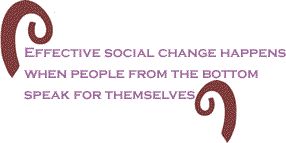
By and large I count myself among those
who believe that what is generally promoted as a race discussion
usually ends up a waste of time. Now that we’re past Black History
Month, during which columnist Clarence Page suggested that his PBS
NewsHour viewers might look to the 1852 Uncle Tom’s
Cabin for racial guidance, maybe we can also get past sepia-toned
reminiscences of slavery and eulogies for Rosa Parks and Coretta
Scott King to the real grainy Technicolor ways folk live today,
or try to. It’s an understatement that the ravishment of the Gulf
Coast, destruction of a major American city and dispossession of
its majority-black residents have set conditions for more than talk.
But that ongoing catastrophe also demands that when we do speak,
we better tell it like it is.
Whenever people say things like Hurricane Katrina “ripped the veil
off racism and poverty” I am reminded of a line from a song in Craig
Brewer’s film Hustle and Flow: “It might be new to you
but it’s been like this for years.” In fact, the film pricked my
race/class sensibilities more than anything else in the midst of
the latest round of race talk.
Shot in the working-class neighborhoods of Brewer’s hometown, Memphis,
Tennessee, Hustle and Flow is the story of DJay (played
by Oscar nominee Terrence Howard), a pimp having a “midlife crisis.”
He’s 35, the same age as his father when he died, and he fears his
life will soon be over unless he changes course.
The film’s look, feel and sound are all intimately familiar. From
the dirt on the walls of a shotgun house to the hot, wet, sticky
red clay-tinted heat of a Southern summer and the ever-present,
almost useless dirty portable fan. From the train track separating
the haves from the have-nots to the get-by job that gets you to
the weekend to the juke joint where anything happens. From the sound
of the blues – even in rap music - right down to the neighborhood,
language and attitudes, Brewer puts a face on the people that those
such as Bill Cosby wish to be invisible. Some of them are even white.
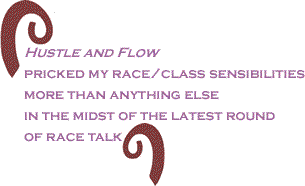
Brewer’s people could be among the
35 percent of blacks currently living below the poverty line in
the United States or the poorest 20 percent or so of Louisiana residents.
Hustle and Flow reveals what Katrina revealed: those who’ve
been left to fend for themselves. In New Orleans almost 40 percent
of households, nearly all of them black, earned less than $20,000
a year.
I have lived in either a predominately black or all-black neighborhood
for most of my forty-nine years. It is not an endorsement of segregation;
it’s just the way it is. Yet, there are a couple of things to appreciate
about longstanding southern black neighborhoods. For one thing,
different economic classes still live amongst one another. They
intermix and interact. This social interaction is represented in
the film by DJay’s relationship with Key, played by Anthony Anderson.
Key, an old school friend, has become a middle-class audio technician.
In addition, many of us move up and down – on and off the economic
ladder throughout our lives. And most demographic data not only
bear out that class intermix but also the precariousness of paycheck-to-paycheck
living. Moreover, the typical black family doesn’t conform to the
2 parents, 2 kids model. Single women head 62% of black families
and 67% of black children are born out of wedlock. Moreover, blacks
more readily accept whites into those communities than vice versa,
even poor whites, even gentrifying white “pioneers.”
Although there has been racial progress in the United States, for
many African Americans life is like ice-skating up hill. According
to the most recent American Housing Survey only 49 percent of blacks
are homeowners as compared with 76 percent of whites. Even with
comparable credit, blacks are 210 percent more likely than whites
to be rejected for a mortgage. When black borrowers are fortunate
enough to get a non-government home loan, a little less than a third
of them will have to bear high-interest sub-prime financing, which
usually doesn’t mesh well with a sub-prime car loan and/or the interest
on a payday loan. No surprise, the national foreclosure rate for
blacks sits right at 50 percent, and half of all African Americans
live in unaffordable, inadequate or crowded housing. Among people
living on the street or in their cars, 40 percent are black.
Wealth, equity, control over property – these markers of the “American
dream” are largely white privileges. At the onset of the last recession,
between 1999 and 2001, the net worth of Hispanic and black households
fell by 27 percent. As of 2002, the Pew Hispanic Center reports,
the median Hispanic household had a net worth of $7,932 and the
median black family had $5,998, while the median white family had
$88,651. And, almost a third of black households and more than a
quarter of Hispanic ones had zero or negative net worth.
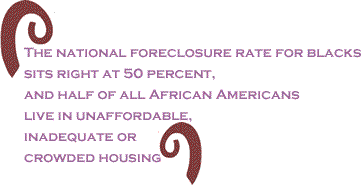
The meaning of the numbers is obvious:
a sizable number of households and the individuals in them are barely
getting by. And those in the middle class are seldom permanently
middle class. That is not to say there are no recognizable class
lines. Lots of black families lead economically stable lives and
have decent credit.
Yet the majority of blacks live under conditions where any little
bind affects their whole life. They are the people who lose their
sub-prime loan homes, choose between car repair or insurance, gas
or taxes, food or medicine, and frequently need an extension on
the electric or phone bill. They rent the cheapest place they can
find and try to hold on in traditional neighborhoods in the face
of just about everything – from economic redlining to strict property
code enforcement to urban pioneering to population disbursement
or marginalization. They routinely face racial profiling and aggressive,
if not brutal, law enforcement, jail and unemployability. A majority
is in the South, where 54 percent of blacks still live. Others are
concentrated in the ghettos although many cities have driven poor
people out of the core of metropolitan areas all across the country.
And then there are those holdouts who occupied the waterfront –
be it the bayous, the barrier islands, along a lake or river, because
that’s where their ancestors fled to – only to have that land taken
by developers, or a storm, because it is waterfront.

That’s why Hustle and Flow is
such a notable picture. It is not just the story of a pimp in Memphis
who needs to make music. It is the story of another city on the
Mississippi delta. New Orleans was built on race dating back to
the day when the first Africans fled out to the bayous to be free
just as a runaway Jim in Huck Finn was attempting to do.
It’s that superficial sense of freedom and abandon that still draws
tourists to a battered New Orleans, although the benefits of an
economy based on the arts and nightlife never will trickle down
to everyone. That is, unless you consider the four-man stand-up
band that used to live in the Ninth Ward and is now playing and
dancing in the street on a weekend night in The French Quarters
for the money out-of-towners throw in the collection box as trickle
down economics.
The film’s climax has the police at DJay’s doorstep after his encounter
with rap mogul Skinny Black, played by rapper Ludacris. And, at
the story’s end DJay is behind bars. Neither situation is unfamiliar.
DJay is from that big neighborhood where, according to the U.S.
Justice Department, the 12 percent of African-American men ages
20 to 34 who are in jail or prison live before and after their release;
where lifespans on average are six years shorter than those of whites;
where having the police at the door, going to court every now and
then or having a family member in jail is not so uncommon.
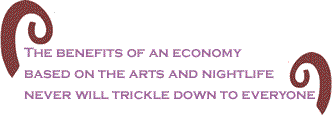
My father’s dad was married a number
of times, legally and not. My pop had three brothers and a sister
by his mom; one brother died young, and the other two served time
on the chain gang, both for murder. One killed a woman, the other
a man, both of them black. My father’s sisters had four sons and
four daughters. Three of the males and two of the females served
time for offenses ranging from the ridiculous to the serious. My
three brothers went to jail in their youth for non-violent offenses,
and I have a few relatives in jail now. Maybe it’s just the odds,
because it almost went wrong for me many times, but I have never
been in jail overnight, although I have been handcuffed more than
a few times and in leg irons once. But I have visited more chain
gangs and work camps, jails, prisons and courtrooms than I care
to remember. Whenever I see the 1967 film Cool Hand Luke it
conjures memories of family visits to take cigars or a carton of
cigarettes to one of my uncles in the camp, or spotting someone
familiar on a road crew, or having a Sunday family picnic lunch
under the pine trees while my incarcerated eldest brother had a
conjugal visit with his girl.
This is not to cop to some inherent criminality in my family in
particular or black people in general or to offer apologies, regrets,
excuses or blame. Sometimes getting caught up with the law is as
simple as making a bad choice. Others times bad programming gets
the best of a person. Or, when folk are raised in and around violence
it should be no surprise when they commit or accept acts of violence.
He or she might be at the wrong place at the wrong time with the
wrong people and just gets caught up in it. And there are those
times when an offense is an act of rebellion against it all, a straight-out
scream because regardless of how racists view blacks or how defeatists
view themselves, all the negative indices of black life are too
huge to be coincidental.
After Katrina, rapper Kanye West famously quipped, “George Bush
doesn’t care about black people.” Most black folk believed it, and
Princeton’s professor Cornel West affirmed it, adding, “...you have
to distinguish between a racist intent and the racist consequences
of his policies.”
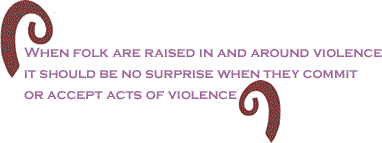
But labeling Bush and placing the problem
solely at his feet is far too simple. Poor people of all hues are
disregarded in both good and bad weather. Though it was class more
than race that determined who got left behind in New Orleans, African
Americans also take it as a matter of fact that the class structure
of this country is built on race. Under the “racist consequences”
standard, Louisiana Governor Kathleen Blanco, a Democrat who gave
the “shoot to kill” order to a police department with a violent
history, and Ray Nagin, the black Democratic mayor who before Katrina
had not factored poor people into any of his political calculations,
would also make the list of failed leaders.
So would former president Bill Clinton, who typically polls in the
high 80 percent approval ratings with blacks. Clinton’s policies
and attitude on due process, equal protection and equal treatment
– otherwise known as civil rights – were horrible. One initiative
required citizens, mostly black, in public housing to surrender
their Fourth Amendment or privacy rights. Another was the “one strike
and you’re out” policy under which public housing residents convicted
of a crime, along with anyone who lives with them, are now evicted
without consideration of their due process rights.
Black incarceration rates during the Clinton years surpassed Ronald
Reagan’s eight years. He stumped for “three strikes and you’re out”
in the federal crime bill, for restrictions on the right of habeas
corpus and expansion of the federal death penalty, and he got them.
When Clinton went into office one in four black men were involved
in the criminal justice system in some way; when he left it was
one in three. DJay represents the one in three.
So what does all this mean? Once again art provides a clue. Hustle
and Flow depicts a society without leaders and how people cope.
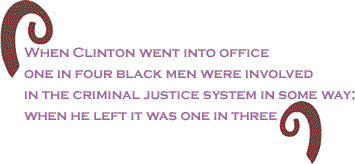
Brewer likens the lead character DJay
to Rocky Balboa. But I see DJay as more like Tom Joad in John Steinbeck’s
The Grapes of Wrath. Joad returns to his Oklahoma home
after a stint in prison to find that his family is leaving to escape
not only the drought but also, a state and class system that is
crushing them. As the 1940 movie adaptation of the novel begins,
Henry Fonda stops in front of a country store named for its location,
“Crossroads.” DJay is at that same place, as is his woman Shug (played
by Taraji Henson), pregnant by Lord knows who, tormented by dreams
of giving birth to “dead dogs” and “nursing a big old catfish,”
worrying that her unborn child is doomed and sensing for the first
time her own creative power.
Standing at the crossroads is the obvious metaphor for where America
is today. There is a feeling across the country that we are headed
in the wrong direction and need to choose a better path.
Washington Post columnist Eugene Robinson said the passing
of Coretta Scott King marked the “end of a ‘black leadership’ era.”
I would mark its demise some thirty-odd years earlier. But often
the good thing about the end of one thing is the start of something
new. The idea that African Americans and the poor must have someone
who speaks for them is at the least annoying and at worst racist.
Who speaks of white leaders? And the problem with most contenders
for the role of national black leader – regardless of who they are
- is that they don’t necessarily rail against what exists. They
usually speak from a privileged perspective and often wrangle over
symbolism or shout over not having a bigger piece of the pie. But
effective social change happens when people from the bottom, speak
for themselves, put pressure on the middle and the top, promotes
a set of values and enforces them. Rosa Parks’ legacy isn’t a solitary
act. Parks, trained in non-violent activism at the Highlander School
in Tennessee, is part of a peoples’ movement that included folk
like Claudette Colvin, who at 15 was arrested for refusing to take
her place on a Montgomery bus nine months before Parks. And it wasn’t
just Martin Luther King Jr. dreaming out loud. The kids who filled
the jails, the “Freedom Riders” and the grassroots voter registrars
were leaders.
African American opposition to the Iraq war today is black leadership.
All those families and individuals discouraging their kin from joining
up to fight have resulted in a decrease in black recruitment and
a crisis for the system. And it didn’t take a leader (other than
George Bush) to set them on course.
The issue of race in America is hard to face, but it is inseparable
from class, which might be why so many African Americans support
the concept of reparations. But though black communities are hit
the hardest, amid staggering wealth disparities and social insecurity
rampant in the land, they are not alone in need of repairing. W.E.B.
Dubois in a 1960 speech at the University of Wisconsin, when presented
with the question “What then is the next step?” called for ”the
stopping of a government of wealth for wealth, and by wealth, and
a returning of governmental power to the individual voter, with
all the freedom of action which can be preserved, along with an
industry carefully organized for the good of the masses of people
and not for the manufacture of millionaires.” Seven years later
King, pushed by black discontent in the cities and mass dissent
from the war, called for “a restructuring of the whole of society.”
That was his Crossroads.
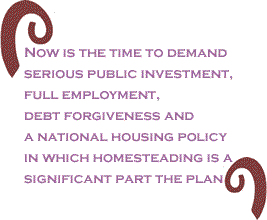
Some complained he was
taking a radical path, but it was the only realistic one for society,
as is plain today. The path for government now should be made clear:
make the unwhole whole, not just Katrina victims in Louisiana and
Mississippi but also the victims of life-changing storms over the
past four years from Florida to North Carolina and the millions
of structurally poor Americans of whatever race for whatever reason.
Now is the time to demand serious public investment, full employment,
debt forgiveness and a national housing policy in which homesteading
is a significant part the plan.
Of course, grassroots advocacy for a new plan begins with Gulf Coast
victims. For the renters and homeowners who lost everything the
demand is simple: Homes. That is not to suggest that those who were
well below sea level for reasons of history should be encouraged
to rebuild in an unsafe area. New Orleans has the opportunity to
rebuild an economically and racially integrated city if America
has the will. That is, rebuild it in a new, more equitable way.
As for the Gulf Coast rebuilding effort, citizens should insist
that federal, state and local officials take the profit out of public
works and put the money in the pockets of those who need it most
instead of making rebuilding efforts into another welfare program
for millionaires.
Finally, while promoting Hustle and Flow on the The
Late Show with David Letterman last year, Terrence Howard commented
that the Hurricane Katrina victims in that city were “waiting on
someone to give them something, instead of doing for themselves.”
If he was referring to those trapped on roofs, in attics and at
overcrowded shelters, he was way off base. If he was referring to
the need for poor people to organize, make a demand and speak and
represent themselves, he’s right.
Kevin Alexander Gray
is president of the South Carolina ACLU and contributing editor
to Black News in Columbia, SC.. Contact
him at [email protected]. |






































